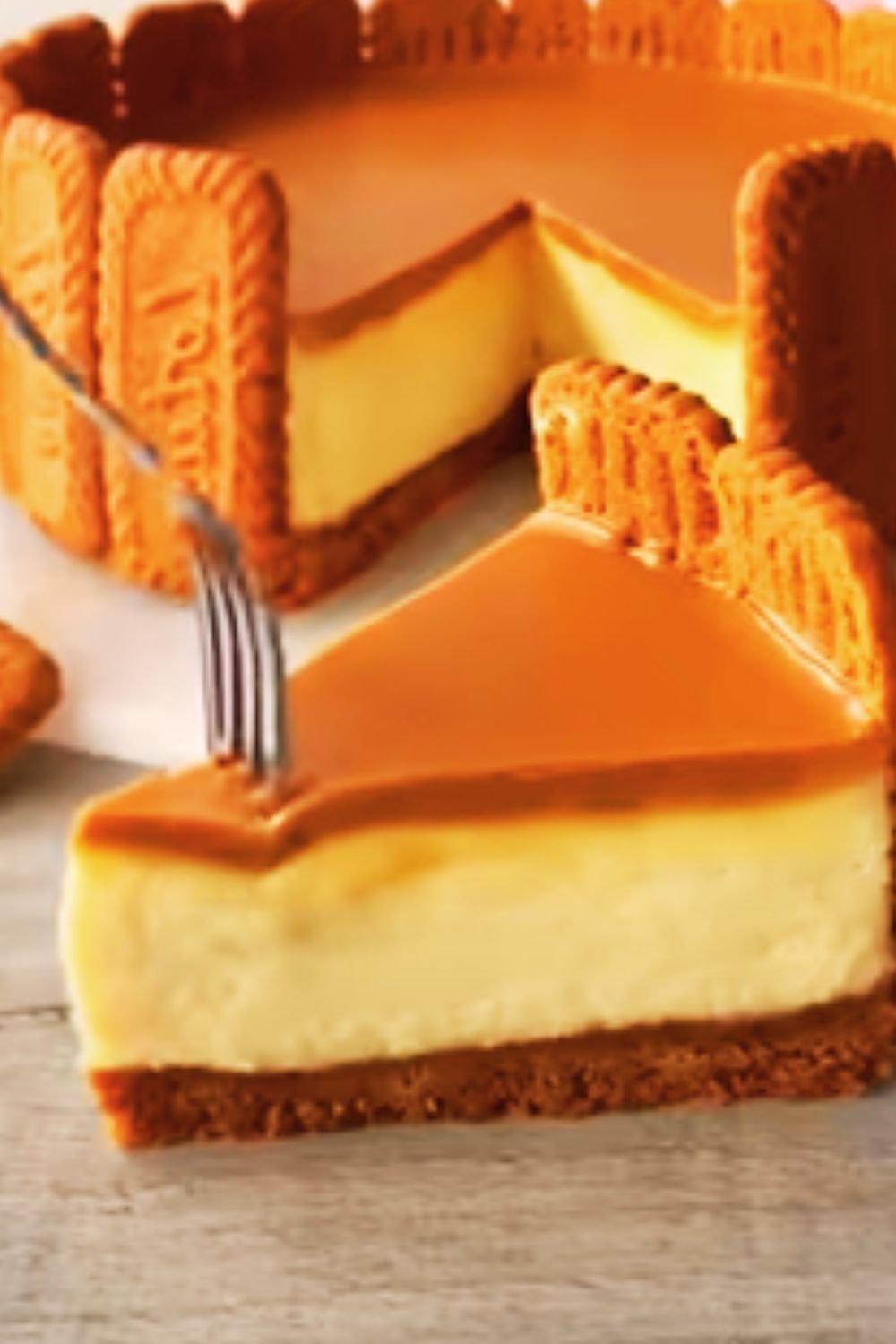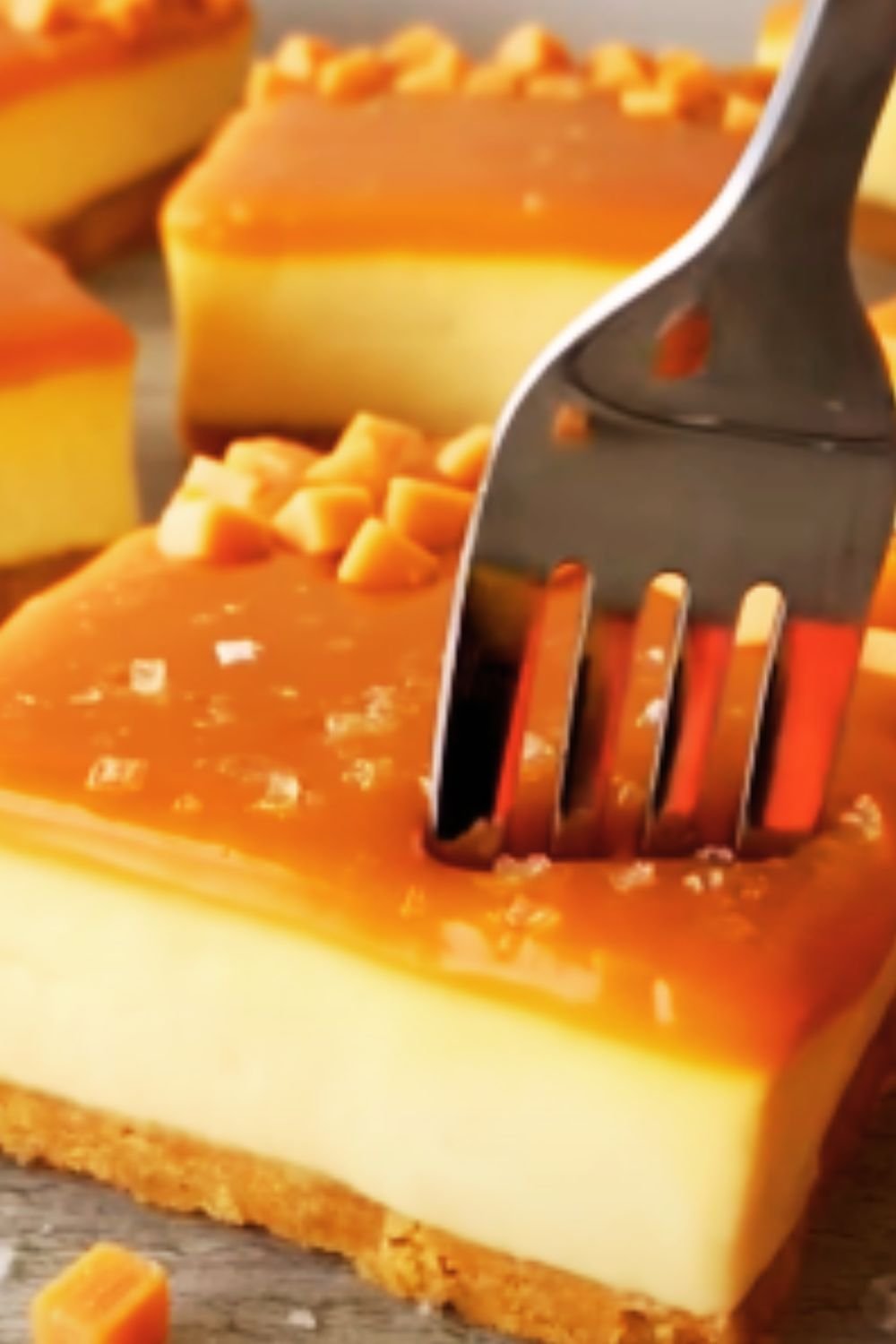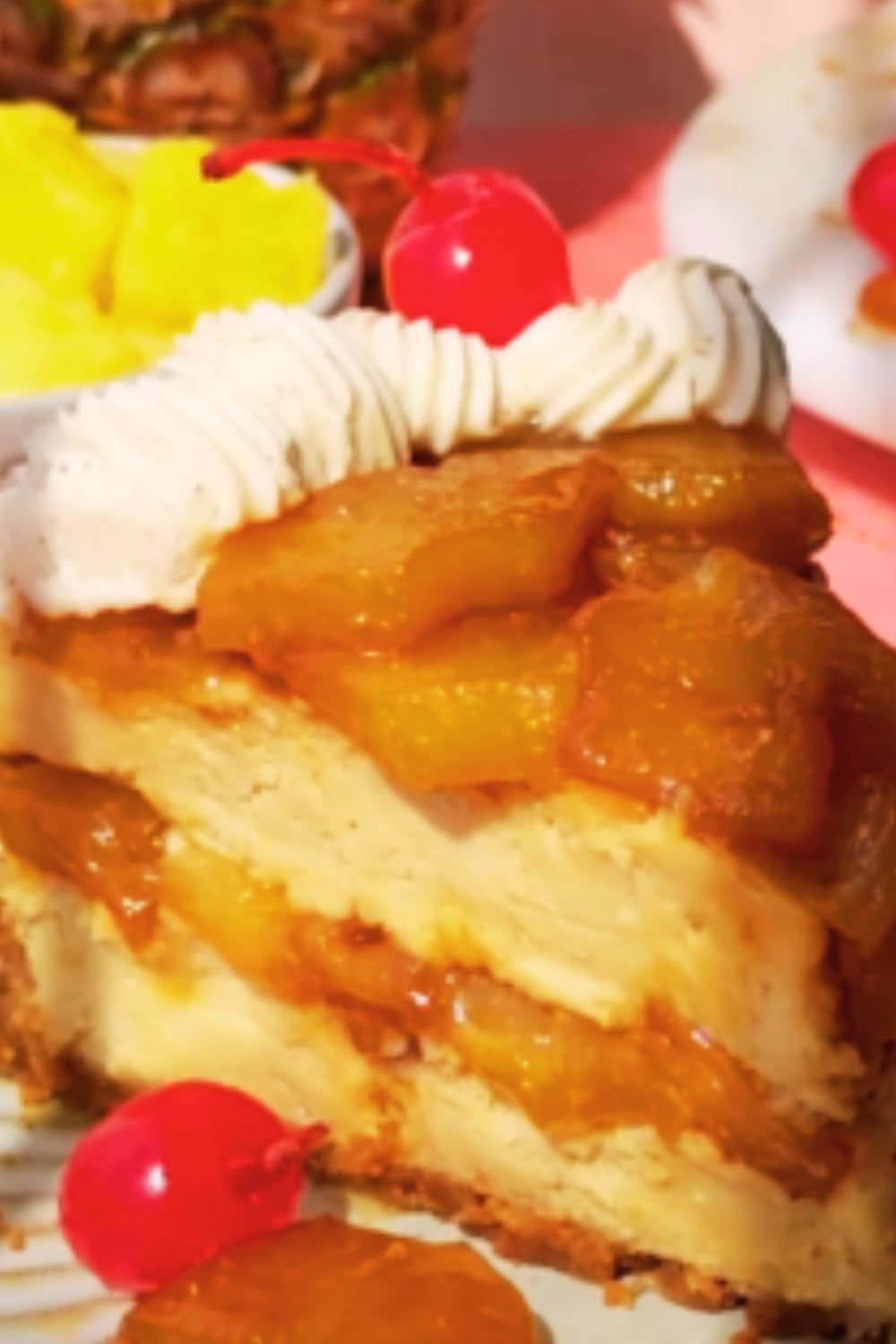There are desserts, and then there are desserts. You know, the kind that make you close your eyes and savor every single bite. The kind that causes an involuntary “mmm” to escape your lips. The kind that haunts your dreams and has you sneaking to the fridge at midnight. This Biscoff Salted Caramel Cheesecake is absolutely one of those desserts.
I’ve been baking cheesecakes for over fifteen years, experimenting with countless flavor combinations, but I must admit that this creation has quickly become my crown jewel. The combination of spiced Biscoff cookies, velvety cream cheese, and the perfect balance of sweet caramel with flaky sea salt creates a dessert experience that’s nothing short of magical.
What Makes This Biscoff Cheesecake Special?
If you’ve never tasted Biscoff cookies (also known as Speculoos), you’re in for a treat. These Belgian spiced cookies have a distinctively warm, caramelized flavor with notes of cinnamon, nutmeg, and ginger. When crushed and combined with butter, they create a crust that puts traditional graham cracker bases to shame.
Add to that a silky-smooth cheesecake filling infused with Biscoff spread, topped with homemade salted caramel sauce, and you’ve got a dessert that will have your guests begging for the recipe.
The Origin Story
I stumbled upon this recipe combination quite by accident. After a trip to Europe where I became somewhat obsessed with Biscoff cookies (they serve them on many airlines too!), I returned home with several packages and a jar of Biscoff spread. Looking for ways to use my treasures beyond simply enjoying them with coffee, I experimented with incorporating them into my classic cheesecake recipe.
The first attempt was good, but not perfect. The second attempt, where I added homemade salted caramel, was an absolute revelation. Since then, I’ve refined the recipe dozens of times, tweaking proportions and techniques until reaching the perfection I’m sharing with you today.
Ingredients You’ll Need
For the Biscoff Cookie Crust:
- 300g (about 2 packages) Biscoff cookies, finely crushed
- 100g unsalted butter, melted
- 1 tablespoon granulated sugar (optional, for extra sweetness)
For the Cheesecake Filling:
- 750g cream cheese, at room temperature (very important!)
- 200g granulated sugar
- 3 large eggs, at room temperature
- 2 teaspoons vanilla extract
- 250g Biscoff spread (smooth version)
- 200ml sour cream, at room temperature
- 2 tablespoons all-purpose flour
For the Salted Caramel Sauce:
- 200g granulated sugar
- 90g unsalted butter, cubed, at room temperature
- 120ml heavy cream, slightly warmed
- 1-1.5 teaspoons flaky sea salt (like Maldon)
For Decoration:
- 100ml heavy cream, whipped to soft peaks
- 6-8 Biscoff cookies, whole and crushed
- Extra Biscoff spread, melted (about 3 tablespoons)
- Extra salted caramel sauce
- Flaky sea salt for sprinkling
Essential Equipment
Before we dive into the recipe, let’s make sure you have everything you need to create this masterpiece:
- 9-inch (23cm) springform pan
- Food processor (for crushing cookies, though a ziplock bag and rolling pin work too!)
- Stand mixer or hand electric mixer
- Parchment paper
- Heavy-bottomed saucepan (for caramel)
- Rubber spatula
- Large roasting pan (for water bath)
- Aluminum foil
- Measuring cups and spoons
- Cooling rack
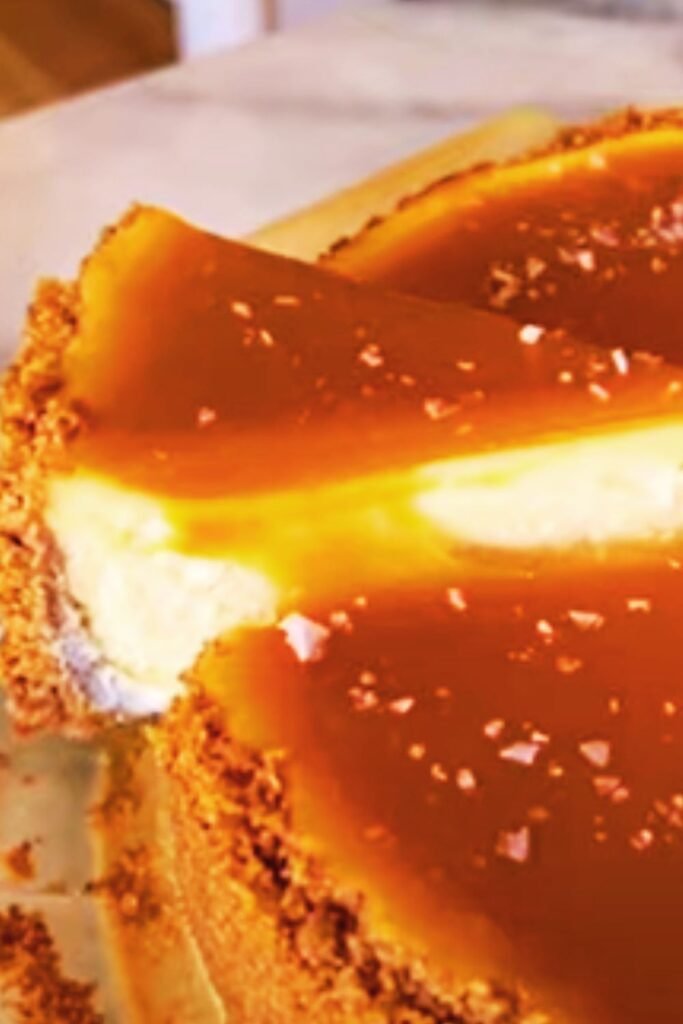
Step-by-Step Instructions
Preparing the Crust:
- Preheat your oven to 325°F (165°C).
- Wrap the outside of your springform pan with a double layer of heavy-duty aluminum foil to prevent water from seeping in during baking.
- Process Biscoff cookies in a food processor until they form fine crumbs.
- Mix cookie crumbs with melted butter and sugar (if using) until the mixture resembles wet sand.
- Press firmly into the bottom and slightly up the sides of your springform pan. I like to use the flat bottom of a measuring cup for this—it creates an even, well-packed crust.
- Bake for 10 minutes, then remove from the oven and let cool completely while you prepare the filling.
Creating the Perfect Cheesecake Filling:
- Reduce oven temperature to 300°F (150°C).
- In a large bowl, beat cream cheese on medium-low speed until completely smooth with no lumps (about 2 minutes). Scrape down the sides frequently!
- Gradually add the sugar and beat until smooth and creamy.
- Add eggs one at a time, beating well after each addition. Be careful not to overbeat once eggs are added—this can cause cracking.
- Mix in vanilla extract.
- Warm the Biscoff spread slightly in the microwave (about 20 seconds) to make it easier to blend.
- Add warmed Biscoff spread to the cream cheese mixture and beat until fully incorporated.
- Fold in sour cream and flour until just combined.
- Pour the filling over the cooled crust, smoothing the top with a spatula.
Water Bath Method (The Secret to Crack-Free Cheesecakes):
- Place your foil-wrapped springform pan into a larger roasting pan.
- Pour hot water into the roasting pan until it reaches about halfway up the sides of the springform pan.
- Carefully transfer the whole setup to the preheated oven.
- Bake for 60-70 minutes, or until the edges are set but the center still has a slight jiggle (it will continue to set as it cools).
- Turn off the oven, crack the door open, and let the cheesecake cool in the oven for 1 hour (this prevents cracking from sudden temperature changes).
- Remove from the oven and water bath, carefully peel away the foil, and let cool completely on a wire rack.
- Once completely cool, refrigerate for at least 6 hours, preferably overnight.
Making the Salted Caramel Sauce:
- In a medium heavy-bottomed saucepan, heat the sugar over medium heat.
- As the sugar begins to melt, gently swirl the pan occasionally (don’t stir!) until all sugar is dissolved and turns a deep amber color.
- Remove from heat and immediately add the butter (be careful, it will bubble vigorously). Whisk until butter is completely melted.
- Slowly pour in the warm heavy cream while whisking constantly (more bubbling will occur).
- Stir in the sea salt.
- Transfer to a heatproof container and let cool completely.
Assembly and Decoration:
- Once the cheesecake is fully chilled, carefully remove it from the springform pan.
- Pour about two-thirds of the cooled salted caramel sauce over the top, spreading it almost to the edges and allowing some to artfully drip down the sides.
- Pipe or spoon whipped cream around the edges.
- Place whole Biscoff cookies around the edge, pressing them gently into the whipped cream.
- Drizzle warmed Biscoff spread over the top.
- Sprinkle crushed Biscoff cookies in the center.
- Drizzle remaining caramel sauce over the top.
- Finish with a light sprinkle of flaky sea salt.
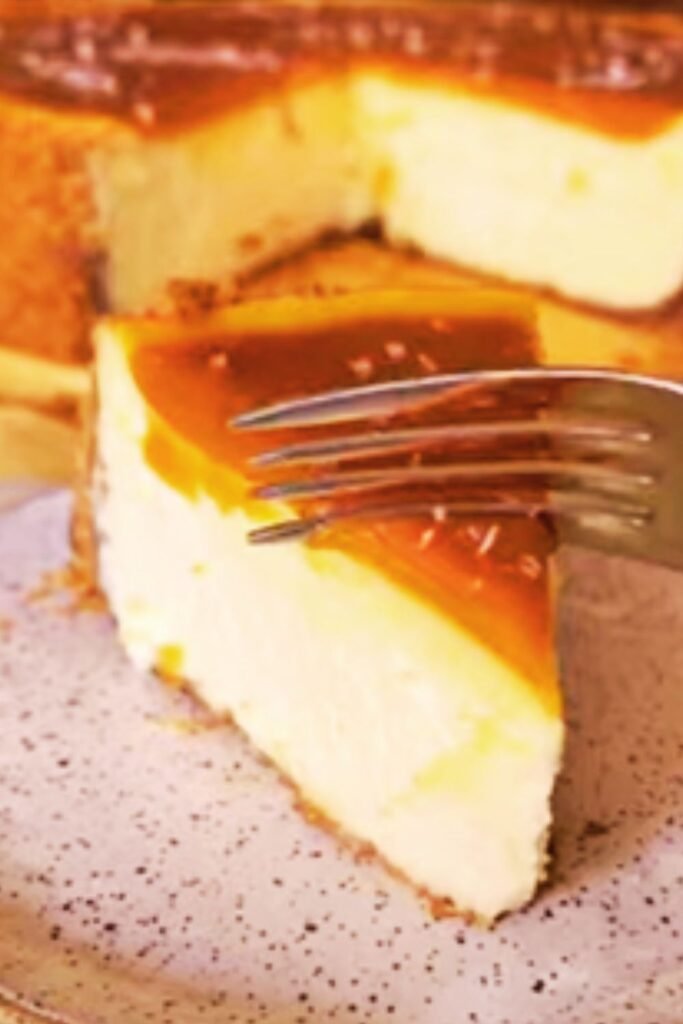
Pro Tips for Cheesecake Success
I’ve made plenty of mistakes with cheesecakes over the years, so learn from my experience with these essential tips:
| Common Issue | Prevention Technique | Why It Works |
|---|---|---|
| Lumpy filling | Use room temperature cream cheese and beat thoroughly before adding other ingredients | Cold cream cheese won’t blend properly and will remain lumpy no matter how long you beat it |
| Cracked top | Always use a water bath and cool gradually | Water bath provides even, gentle heat distribution; gradual cooling prevents sudden temperature changes that cause cracks |
| Soggy crust | Double-wrap pan with heavy-duty foil and pre-bake the crust | Double protection against water seepage; pre-baking sets the crust before adding wet filling |
| Sunken center | Don’t open the oven during baking | Sudden temperature changes cause uneven rising and falling |
| Sticking to pan | Run a thin knife around the edge after initial cooling | Releases the sides before they can stick firmly due to contraction during cooling |
| Difficult slicing | Use a warm, clean knife for each cut | Warmth prevents the filling from sticking to the knife, creating cleaner slices |
| Uneven texture | Don’t overbeat after adding eggs | Overbeating incorporates too much air, causing uneven baking and texture problems |
Make-Ahead and Storage Information
This cheesecake is perfect for preparing in advance, as it actually improves with a bit of time! Here’s a detailed timeline:
| Timeframe | Storage Method | Notes |
|---|---|---|
| 1-2 days ahead | Refrigerate whole, uncovered for 1 hour then cover with plastic wrap | Flavors meld and develop; add toppings just before serving |
| 3-5 days | Refrigerate covered | Quality remains excellent |
| Up to 2 weeks | Refrigerate, with extra protection against odors | Quality begins to diminish slightly after 5 days |
| 1-2 months | Freeze without toppings, double-wrapped | Thaw overnight in refrigerator |
| Individual slices | Freeze in airtight containers | Perfect for portion control |
Variations to Try
While this recipe is absolutely perfect as is, I’ve experimented with several delicious variations you might want to try:
Chocolate Biscoff Cheesecake:
Add 150g melted and cooled dark chocolate to the filling for a chocolate-spice flavor explosion.
Mini Biscoff Cheesecakes:
Use a muffin tin lined with paper liners to create individual cheesecakes. Reduce baking time to about 20-25 minutes.
No-Bake Version:
Replace eggs with 2 tablespoons of gelatin bloomed in 1/4 cup cold water then dissolved in 1/4 cup hot water. Chill until set (about 4-6 hours).
Vegan Alternative:
Substitute cream cheese with vegan cream cheese, eggs with a flax egg mixture, and heavy cream with coconut cream. Note that texture will be slightly different but still delicious.
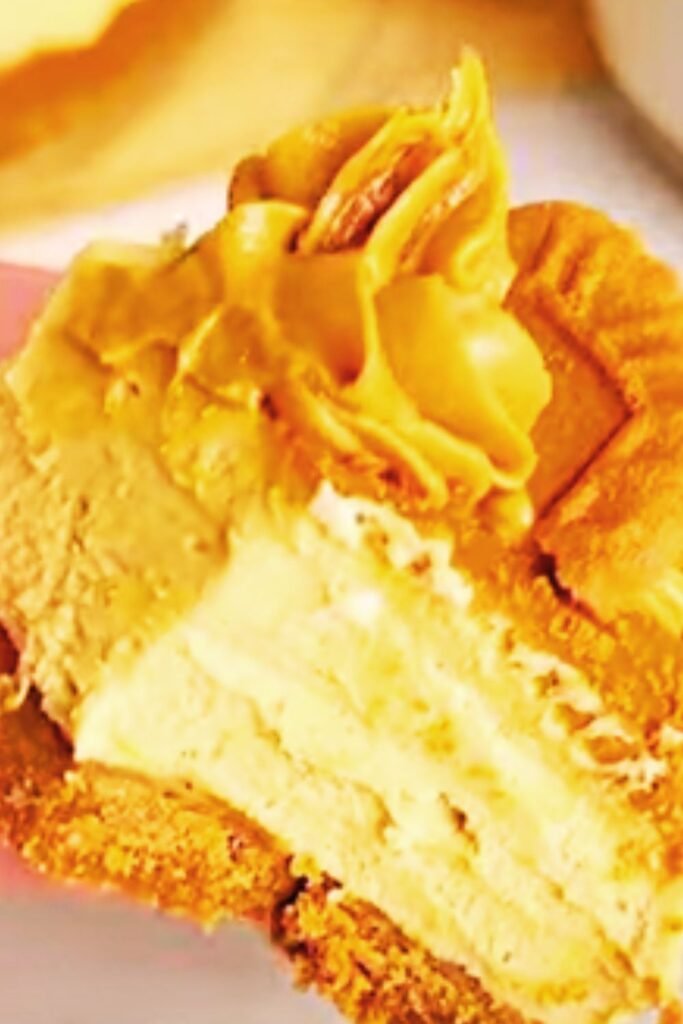
Serving Suggestions
For the ultimate dessert experience, I recommend serving this cheesecake with:
- A small scoop of vanilla bean ice cream
- A shot of espresso or cappuccino
- Fresh berries on the side (raspberries pair particularly well)
- A glass of dessert tea like vanilla rooibos or chai
For special occasions, consider adding a gold leaf decoration or sparklers for a spectacular presentation.
Troubleshooting Guide
Even experienced bakers encounter problems sometimes. Here’s how to handle common issues:
| Problem | Possible Cause | Solution |
|---|---|---|
| Caramel crystallizes | Sugar crystals on sides of pan | Brush sides of pan with water before heating; don’t stir during initial melting |
| Caramel too dark/burnt | Heat too high | Use medium-low heat and watch carefully; have ingredients ready |
| Cheesecake too soft | Underbaking | Extend baking time; center should still jiggle slightly but not be liquid |
| Crust too hard | Overbaking or too much butter | Reduce pre-baking time; check butter proportions |
| Filling too sweet | Recipe balance | Reduce sugar by up to 50g; increase salt slightly |
| Filling not Biscoff-y enough | Not enough spread | Increase Biscoff spread to 300g and reduce cream cheese by 50g |
Nutritional Information
While this is definitely an indulgent treat, here’s the approximate nutritional breakdown per slice (assuming 12 slices per cheesecake):
| Nutrient | Amount per Serving |
|---|---|
| Calories | Approximately 650 |
| Fat | 45g (28g saturated) |
| Carbohydrates | 55g |
| Sugar | 40g |
| Protein | 8g |
| Sodium | 390mg |
| Fiber | 1g |
Questions & Answers
Is it necessary to use a water bath when baking the cheesecake? While you technically can skip this step, I strongly advise against it. The water bath provides gentle, even heat that prevents cracks and creates that silky-smooth texture that makes this cheesecake so luxurious. The extra few minutes of preparation are absolutely worth it.
Can I use store-bought caramel sauce instead of making my own? You can, but I really encourage you to try making your own. Homemade caramel has a depth of flavor that store-bought simply can’t match. Plus, you can control the salt level to create the perfect sweet-salty balance. If you must use store-bought, choose a premium brand and add extra flaky sea salt.
Why do the ingredients need to be at room temperature? Room temperature ingredients blend together more easily and create a smoother texture. Cold cream cheese, in particular, will remain lumpy no matter how long you beat it. Take everything out of the refrigerator at least 2 hours before you begin.
Can I make this without Biscoff spread? The Biscoff spread is what gives this cheesecake its distinctive flavor, but in a pinch, you could substitute cookie butter from Trader Joe’s or another brand. The flavor profile will be slightly different but still delicious.
My caramel sauce solidified after cooling. What happened? This usually happens if the ratio of sugar to cream was off. Gently reheat it with an additional 2-3 tablespoons of warm heavy cream, stirring until smooth.
How do I know when the cheesecake is done baking? The edges should be set but the center should still have a slight jiggle (about a 2-3 inch circle in the center). It will continue to set as it cools. If the entire cheesecake is jiggly, it needs more time.
Can I freeze leftover cheesecake? Absolutely! Cheesecake freezes beautifully. Wrap individual slices tightly in plastic wrap, then aluminum foil, and freeze for up to 2 months. Thaw overnight in the refrigerator before serving.
I don’t have a springform pan. What can I use instead? In a pinch, you can use a deep dish pie plate or a cake pan lined with parchment paper with overhanging edges to help lift the cheesecake out after cooling. The presentation won’t be quite the same, but the taste will still be fantastic.
A Final Note
Creating the perfect cheesecake is part science, part art, and entirely worth the effort. Don’t be discouraged if your first attempt isn’t picture-perfect—even with a few imperfections, this Biscoff Salted Caramel Cheesecake will still taste divine.
The marriage of spiced cookies, creamy cheesecake, and salted caramel creates a dessert that’s sophisticated yet comforting, impressive yet accessible. It’s become my signature dessert for good reason, and I’m willing to bet it might become yours too.
Remember, the key to baking success is patience. Don’t rush the process—allow time for ingredients to come to room temperature, for the cheesecake to bake slowly, for proper cooling, and for overnight chilling. Your patience will be rewarded with cheesecake perfection.

Share your creations with me by tagging your photos online—I’d love to see your versions of this recipe! Happy baking!
